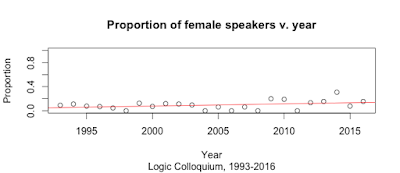Now that we have some idea of the general trends in the proportions of male and female speakers over time in each of the
four ASL conference series, let's look at the question of whether male and female speakers receive repeat invitations at similar rates. I'm going to ask this question two different ways.
Are the proportions of male and female speakers who speak more than once at ASL conferences similar?
The answer to this question appears to be yes for the conference series for which such an analysis is possible. Here are tables of the basic data (please note that all talks mentioned in this post are invited talks):
|
Annual Meetings |
Logic Colloquium |
|
Men |
Women |
Men |
Women |
|
| 1 talk |
127 |
18 |
213 |
20 |
| 2+ talks |
49 |
6 |
77 |
9 |
| Percentage: 2+ talks |
27.84% |
25% |
26.55% |
31.03% |
|
AMS/ASL |
APA/ASL |
|
Men |
Women |
Men |
Women |
|
| 1 talk |
93 |
20 |
63 |
6 |
| 2+ talks |
24 |
2 |
19 |
3 |
| Percentage: 2+ talks |
20.51% |
9.09% |
23.17% |
33.33% |
I used a chi-square test to determine whether women and men speak more than once at these meetings at statistically distinguishable rates.
When I carried out this analysis, I found that the p-value for the Annual Meetings is 0.9611, and the p-value for the Logic Colloquium is 0.7648. There is no reason to reject the hypothesis that multiple invitations are issued to men and women at the same rate!
However, I can't carry out this analysis for the AMS/ASL and APA/ASL meetings. The reason is that in general, a reliable chi-square analysis can't be done unless each category has at least 5 people in it. Only 2 women have given more than one talk since 1995 at an AMS/ASL meeting, and only 3 women have given more than one talk since 1998 at an APA/ASL meeting. In fact, only 9 distinct women have spoken at APA/ASL meetings in this time, so there is no way there could have been at least 5 women in both of these categories. It doesn't say anything very good about the number of women who are asked to speak at these meetings multiple times if there aren't enough for me to do a chi-square test.
Now let's ask another, related question:
Are the proportions of male and female speakers who speak n times at ASL conferences similar for each n?
In the analysis above, I didn't distinguish between speakers who spoke two, three, four, or five times: I combined all of these into a single "2+" category. Let's see what it looks like when I don't combine these categories:
|
Annual Meetings |
Logic Colloquium |
|
Men |
Women |
Men |
Women |
|
| 1 talk |
127 |
18 |
213 |
20 |
| 2 talks |
38 |
6 |
48 |
7 |
| 3 talks |
10 |
0 |
25 |
2 |
| 4 talks |
0 |
0 |
3 |
0 |
| 5 talks |
1 |
0 |
1 |
0 |
|
AMS/ASL |
APA/ASL |
|
Men |
Women |
Men |
Women |
|
| 1 talk |
93 |
20 |
63 |
6 |
| 2 talks |
22 |
2 |
12 |
3 |
| 3 talks |
2 |
0 |
5 |
0 |
| 4 talks |
0 |
0 |
2 |
0 |
As you can see, I cannot analyze this data statistically for any conference: there simply aren't enough people in most of the categories. I'll just note that while 49 men have given more than two talks in any of these series, only 2 women have: 3.92% of the people who have given more than two talks in a single ASL conference series in the time frames I considered were women.
Summary: In the conference series in which enough women have given multiple talks to analyze, there is no statistically significant difference in the rates at which women and men are asked to give more than one talk. However, this analysis is only possible in two of the four series. Furthermore, when we consider not only whether male and female speakers give more than one talk but also how many invitations they receive, no series can be analyzed statistically, but women seem to be underrepresented among speakers who are invited more than twice.
It's worth noting that if I considered invited talks in all of these ASL conference series together, my findings might be different. I might look at this someday: at this point, the data in this spreadsheet is not consistently formatted, and that makes this particular analysis very difficult.
Next up: The ASL adopted its statement on women in logic at the Annual Meeting in 2012. Let's see if that seems to have had any effect on the proportion of female speakers at ASL meetings since then.


















